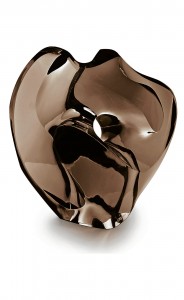
“Brilliance,” to gemologists, is the fiery light that shines out of a gemstone’s core, coaxed to optimal brightness via maximal refraction that results from expert faceting.
It is no coincidence then that sculptor Ramon Orlina’s latest body of works bears the same title. For collectors, his works are gems created through a process akin to the transformation of rough stones to precious jewels.
Orlina has never taken light lightly, having been a practicing architect before his first solo show in 1975. Integral in edifice design is adequate lighting, whether natural or artificial, and it is apparent that he follows the same principle when he sculpts. His acclaim is, in fact, built on his ability to free arresting forms and illumination from almost opaque masses of glass and crystal.
Initiates to the lustrous Orlina trove must note that he is the only Filipino artist who executes with a method that suits marble, wood and stone, a method he has modified and personalized to fit his style and chosen medium. He has created his own niche with his popular green-glass material, which is actually industrial refuse from an architectural glass manufacturing company.
His good relations with the firm endures and is testament to both parties’ commitment to having industrial by-product see new aesthetic life.
Architectural background
His training as an architect has certainly served as robust foundation.

Frank Lloyd Wright is known for his glass design like the stained prairie windows. But his most famous creation is the Guggenheim Museum in New York, whose spiral construction provides the ideal vantage point for the full appreciation of the artworks inside. (This consideration is also evident in Orlina pieces, as they may be enjoyed from any angle.)
But it is Frank Gehry, the maverick behind the Guggenheim in Bilbao, Spain, who is honored by Orlina in his latest show.
“Tribute to Frank Gehry” seems a vitrified miniature of what could possibly be Gehry’s monumental sculpture/building. It reveals who Orlina, from time to time, looks to for structural flair. Planar curvatures and pointed protrusions resembling mathematical graphs that often define Gehry’s fantastic buildings are echoed in Orlina’s glass abstractions.
However the sculptures are shaped, they all appear to be buttressed by the three architectural pillars of strength, purpose and aesthetics. The requirement of durability is fulfilled as the sculptures display structural integrity crucial to the breakable material.
The artist does functional pieces. He has, for instance, created a champagne fountain in the past. Featured in this collection are the craggy expanses of “Unity” and “Green Earth,” whose illuminated bases double as ornamental lighting.
What excite loyal followers are the additions of color and theme. The greens, which are already popular (and, for some, represent bounty and prosperity), vary—from their original hue to moss and blue green, such as in “Flowers of Liberty,” among the artist’s first glass garden pieces.
The horticultural foray certainly gives new meaning to “cut flowers.” Other organic pieces come in peach, the hue of orange, said to deepen charm.
Charming indeed is “Subli,” a figure caught kneeling with arms folded as choreographed in the dance that venerates the Holy Cross. The folk dance is still performed to this day in Taal, Batangas, the artist’s province. The opaque solid base seems to allude to the artist’s deep religious devotion and the rendering of local culture speaks of pride for his provincial roots.
Not entirely new but still uncommon is azure blue crystal. The color invokes calm and balance and is apt for “Harmony,” supported fittingly by the clarity of a colorless base.
Whether in three-dimensional abstracts, cubist figures, or portions of smoothly curving bodies, key deep intrusions allow light passages and make deflection as well as reflection possible. Thus, in removal is enhancement: When indentations are made, or when grooves are created, they release fire that sears—and crafts—gemstones.
But where gems are expected to release fire, an Orlina oeuvre radiates undulating flame and brilliance.
“Brilliance” is on view at the 2/L, Archeology Hall, Power Plant Mall, Rockwell, Makati City. Call tel. 6667755 or visit www.gallerybig.com.
For comments, e-mail the author at majorday@gmail.com.

